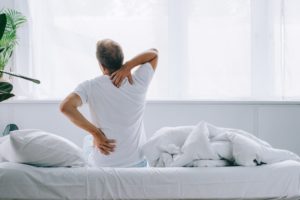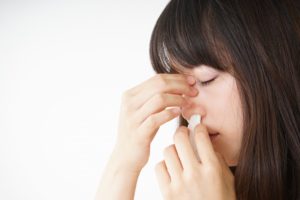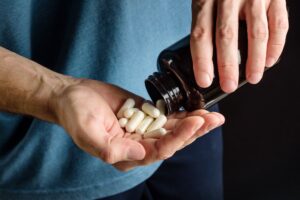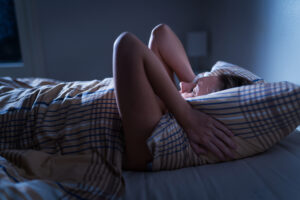When you buy through our links, we may earn a commission. Products or services may be offered by an affiliated entity. Learn more.
Normal Oxygen Levels While Sleeping
- What Happens to Your Oxygen Levels During Sleep?
- What Do Blood Oxygen Level Readings Mean?
- How Low Can Your Oxygen Levels Go During Sleep?
- What Is a Dangerously Low Oxygen Level While Sleeping?
- What Are Signs of Low Oxygen During Sleep?
- What Causes Low Oxygen While Sleeping?
- How Can You Improve Oxygen Levels During Sleep?
- When Should You Seek Medical Help?
- Normal oxygen levels while sleeping typically range from 95% to 100% for healthy individuals.
- During sleep, especially in deeper stages, it’s normal for levels to dip slightly, but readings consistently below 88% may indicate a breathing issue like sleep apnea.
- Monitor your oxygen levels and seek medical attention if accompanied by symptoms like chest pain, shortness of breath, rapid heartbeat, or blue nail beds, lips, or face.
You might not think much about your breathing once you drift off to sleep—but your body sure does. As you rest, your lungs and blood work together to keep oxygen flowing to your brain and vital organs. While it’s normal for oxygen levels to dip slightly during sleep, especially in deeper stages, significant drops can signal an underlying issue. Understanding what’s normal—and what’s not—can help you sleep more soundly and catch health concerns before they escalate.
| Blood Oxygen Level | Interpretation |
|---|---|
| 95 to 100% | Normal range |
| 91 to 95% | Borderline low |
| 88 to 91% | Low |
| Lower than 88% | Dangerously low |
What Happens to Your Oxygen Levels During Sleep?
As you sleep, your breathing naturally slows and becomes less consistent, especially as you cycle through different sleep stages. It’s normal to experience brief periods of slower or shallower breathing, and even short pauses in breath. These changes can cause a slight drop in blood oxygen levels, which usually isn’t a cause for concern in healthy individuals.
However, if oxygen levels drop too low or remain low for extended periods, it could signal an underlying health problem. Since your body’s tissues rely on oxygen to function properly, prolonged or significant oxygen deprivation during sleep can pose serious health risks and may require medical attention.
Oxygen Dropping? It Could Be a Sign of Sleep Apnea
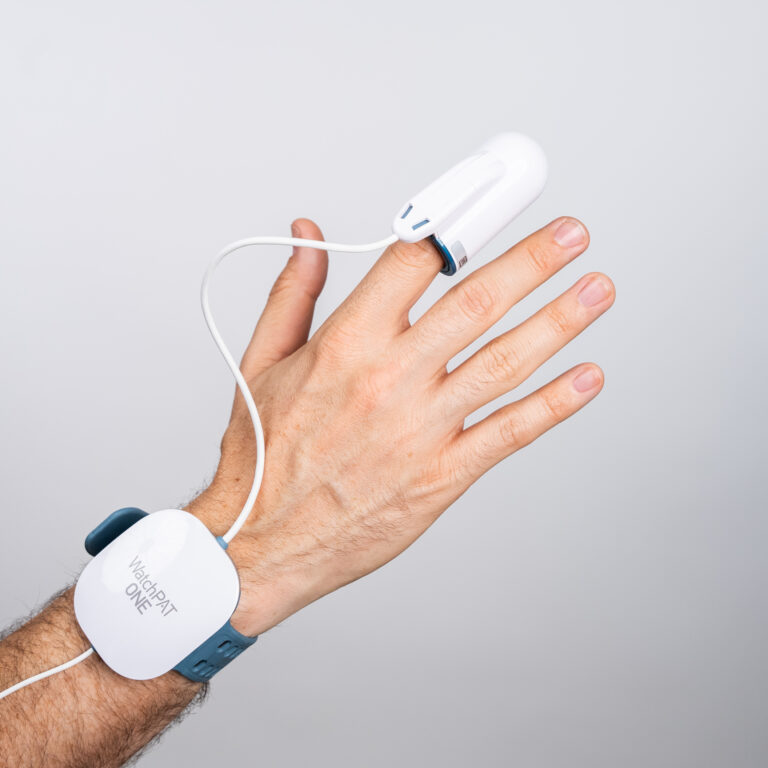
our partner at sleepdoctor.com
10% off Home Sleep Tests
Buy Now“Truly grateful for this home sleep test. Fair pricing and improved my sleep!”
Dawn G. – Verified Tester
What Do Blood Oxygen Level Readings Mean?
Blood oxygen levels measure the percentage of a person’s red blood cells that carry oxygen, which is sometimes called blood oxygen saturation . Oxygen saturation reflects how effectively the lungs are taking in oxygen and delivering it into the bloodstream.
Normal blood oxygen levels range from 95% to 100% for healthy individuals. However, blood oxygen levels at or below 88% for five or more minutes during sleep may be a sign of a sleep-related breathing disorder like sleep apnea.
Doctors and nurses usually measure blood oxygen levels using a pulse oximeter . A pulse oximeter is a small, painless clip typically placed on a person’s fingertip. When pulse oximeters are worn over a prolonged period, such as during sleep, they can record blood oxygen levels continuously over time.
A blood gas test is another way of measuring blood oxygen levels. Although generally more accurate, blood gas tests require a blood draw, can’t be performed at home, and only measure levels at a single point in time. For that reason, pulse oximeters are better suited for at-home monitoring of blood oxygen levels during sleep. Sleep trackers can also be used to check blood oxygen levels. For example, the Oura Ring measures blood oxygen, heart rate, and heart rate variability along with key sleep metrics.
Blood oxygen levels can vary slightly during sleep. For example, oxygen saturation levels may show a minor increase or decrease with changes in sleeping position . Blood oxygen levels may be slightly lower, but still within normal ranges, while a person lies on their back compared with when they lie on their stomach.
How Low Can Your Oxygen Levels Go During Sleep?
Many factors influence the interpretation of oxygen levels, so there’s no universal standard for normal oxygen levels. That said, blood oxygen levels above 95% are normal for most people. In certain circumstances, though, blood oxygen levels above 95% may be too high , such as in some people with chronic obstructive pulmonary disease (COPD).
People monitoring their blood oxygen levels at home should make note of any unexplained changes to their usual levels, even if their oxygen saturation stays above 95%. Blood oxygen levels usually only change by about one percentage point each hour , so people should talk to their doctors about larger drops.
Oxygen saturation at or below 92% is too low for most people. However, levels between 89 to 92% may be expected for some people with chronic lung disease. Anyone who is monitoring their blood oxygen levels should talk to their doctor about the right level for them and what level should be considered too low.
People should get medical care as soon as possible if their blood oxygen levels drop to or below 88%.
Some people regularly have lower blood oxygen levels during sleep. For example, people living at high altitudes may have lower-than-average oxygen saturation. People with COPD or other chronic lung diseases also typically have lower blood oxygen levels during sleep. In addition, some people with disorders of the chest muscles or nerves may have chronically low blood oxygen levels at night.
What Is a Dangerously Low Oxygen Level While Sleeping?
Blood oxygen levels at or below 88% are considered dangerously low for most people. When a person’s blood oxygen levels drop too low , their vital organs may not get enough oxygen.
Sleep-related hypoxemia is a disorder involving blood oxygen levels that fall to 88% or below for at least five minutes during sleep without hypoventilation or another sleep-related breathing disorder. In children, drops in oxygen saturation to 90% or below for five minutes or more may also meet the criteria for sleep-related hypoxemia.
Sleep-related hypoxemia is typically caused by another health condition. A variety of medical issues have been linked to sleep-related hypoxemia, including COPD, sickle cell disease, and pneumonia.
Obstructive and central sleep apnea can also cause drops in blood oxygen levels while sleeping. However, oxygen saturation usually only drops for less than a minute at a time in these conditions, while reduced levels in sleep-related hypoxemia usually last for several minutes.
Opioid painkillers, alcohol, sleeping pills, and certain anxiety drugs may be linked to both lower blood oxygen levels and slowed breathing during sleep. People with sleep-related breathing disorders, heart disease, or lung disorders should be cautious and talk with their doctor before taking these substances.
What Are Signs of Low Oxygen During Sleep?
Low oxygen levels during sleep, also known as nocturnal hypoxemia, can sometimes go unnoticed, but your body often gives warning signs. If your blood oxygen drops too low at night, you may experience symptoms that affect both your sleep and how you feel during the day. Watch for the following signs:
- Frequent nighttime awakenings or restlessness
- Gasping, choking, or snoring during sleep
- Morning headaches
- Waking up feeling tired despite a full night’s rest
- Shortness of breath when waking up
- Excessive daytime sleepiness
- Difficulty concentrating or memory issues
- Bluish tint to the lips, fingers, or toes (in more severe cases)
If you notice any of these symptoms, especially alongside a diagnosed sleep disorder or other health conditions, it’s important to talk to a doctor. Monitoring your oxygen levels with a pulse oximeter or sleep study can help determine whether low oxygen is affecting your sleep quality and overall health.
What Causes Low Oxygen While Sleeping?
Several conditions and factors can interfere with your breathing during sleep, leading to a drop in blood oxygen levels. Some are temporary or environmental, while others may be linked to chronic health issues. Common causes of low oxygen during sleep include:
- Obstructive sleep apnea: repeated pauses in breathing caused by airway blockages during sleep
- Central sleep apnea: failure of the brain to send proper signals to the muscles that control breathing
- Chronic obstructive pulmonary disease (COPD): damaged lungs struggle to maintain oxygen levels
- Asthma: nighttime airway inflammation or tightening can reduce airflow
- Obesity hypoventilation syndrome: excess weight puts pressure on the lungs and chest wall
- Pneumonia or other respiratory infections: temporarily reduce lung function and oxygen intake
- High altitudes: thinner air contains less oxygen, which may affect breathing during sleep
- Smoking: can damage lung tissue and reduce oxygen absorption
- Certain medications: sedatives and muscle relaxants can slow breathing
How Can You Improve Oxygen Levels During Sleep?
If you’re experiencing low oxygen levels during sleep, there are several strategies that may help boost oxygen intake and improve your overall sleep quality. Some changes can be made at home, while others may require medical evaluation or treatment:
- Sleep on your side or elevate your head: Sleeping on your back can worsen breathing issues for some people. Try sleeping on your side or using a wedge pillow to keep your upper body elevated, which can help open your airways.
- Use a CPAP or BiPAP machine: For people with sleep apnea or certain respiratory conditions, continuous positive airway pressure (CPAP) or bilevel positive airway pressure (BiPAP) therapy can keep airways open and ensure adequate oxygen levels throughout the night.
- Avoid alcohol and sedatives before bed: These substances can slow your breathing and increase the risk of low oxygen levels, especially in people with underlying respiratory problems.
- Stop smoking: Smoking damages the lungs and reduces their ability to absorb oxygen. Quitting can improve lung function and oxygen levels over time.
- Keep your bedroom air clean: Use an air purifier to reduce allergens, dust, and pollutants that may affect breathing. If you’re using supplemental oxygen, make sure equipment is functioning properly.
- Exercise regularly: Physical activity can strengthen your lungs and heart, helping your body use oxygen more efficiently—even during sleep.
- Manage underlying health conditions: Conditions like asthma, COPD, or heart disease can interfere with oxygen levels at night. Work with your healthcare provider to keep these conditions under control.
When Should You Seek Medical Help?
People should contact a health care provider if their blood oxygen levels drop below 93%, and they should seek prompt medical care if levels are below 88%. It’s also important to seek medical attention when experiencing symptoms of a lack of oxygen, including:
- Shortness of breath
- Chest pain
- Rapid heartbeat
- Blue nail beds, lips, or face
Some people may not have symptoms despite having low oxygen levels during sleep, or they may experience only general feelings of fatigue or unrefreshing sleep.
Sudden, severe drops in blood oxygen levels can be a medical emergency. A repeated lack of oxygen delivered to vital organs can increase the risk of serious medical conditions, including stroke and heart failure.
Promptly seeing a doctor about low oxygen levels can allow the doctor to provide supplemental oxygen if it’s needed, investigate the underlying cause, and start appropriate treatment.

Still have questions? Ask our community!
Join our Sleep Care Community — a trusted hub of sleep health professionals, product specialists, and people just like you. Whether you need expert sleep advice for your insomnia or you’re searching for the perfect mattress, we’ve got you covered. Get personalized guidance from the experts who know sleep best.
References
9 Sources
-
A.D.A.M. Medical Encyclopedia. (2021, July 27). Pulse oximetry. MedlinePlus.
https://medlineplus.gov/lab-tests/pulse-oximetry/ -
Badr, M. (2022, September 6). Sleep-related breathing disorders in COPD. In U. Hatipoglu (Ed.). UpToDate.
https://www.uptodate.com/contents/sleep-related-breathing-disorders-in-copd -
Dezube, R. (2022, September). Arterial blood gas (AGB) analysis and pulse oximetry. Merck Manual Consumer Version.
https://www.merckmanuals.com/home/lung-and-airway-disorders/diagnosis-of-lung-disorders/arterial-blood-gas-abg-analysis-and-pulse-oximetry -
Ceylan, B., Khorshid, L., Güneş, Ü. Y., & Zaybak, A. (2016). Evaluation of oxygen saturation values in different body positions in healthy individuals. Journal of clinical nursing, 25(7-8), 1095–1100.
https://pubmed.ncbi.nlm.nih.gov/26879626/ -
Carter, R. & Nwasuruba, C. (2022, December 7). Long-term supplemental oxygen therapy. In J. Stoller (Ed.). UpToDate.
https://www.uptodate.com/contents/long-term-supplemental-oxygen-therapy -
Bhogal, A. S., & Mani, A. R. (2017). Pattern Analysis of Oxygen Saturation Variability in Healthy Individuals: Entropy of Pulse Oximetry Signals Carries Information about Mean Oxygen Saturation. Frontiers in physiology, 8, 555
https://pubmed.ncbi.nlm.nih.gov/28824451/ -
American Academy of Sleep Medicine. (2014). The International Classification of Sleep Disorders – Third Edition (ICSD-3). Darien, IL.
https://aasm.org/ -
Kramer, N., Millman, R., & Hill, N. (2022, May 12). Evaluation of sleep-disordered breathing in patients with neuromuscular and chest wall disease. In G. Finlay (Ed.). UpToDate.
https://www.uptodate.com/contents/evaluation-of-sleep-disordered-breathing-in-patients-with-neuromuscular-and-chest-wall-disease -
Theodore, A. (2022, November 22). Measures of oxygenation and mechanisms of hypoxemia. In P. Parsons (Ed.). UpToDate.
https://www.uptodate.com/contents/measures-of-oxygenation-and-mechanisms-of-hypoxemia










